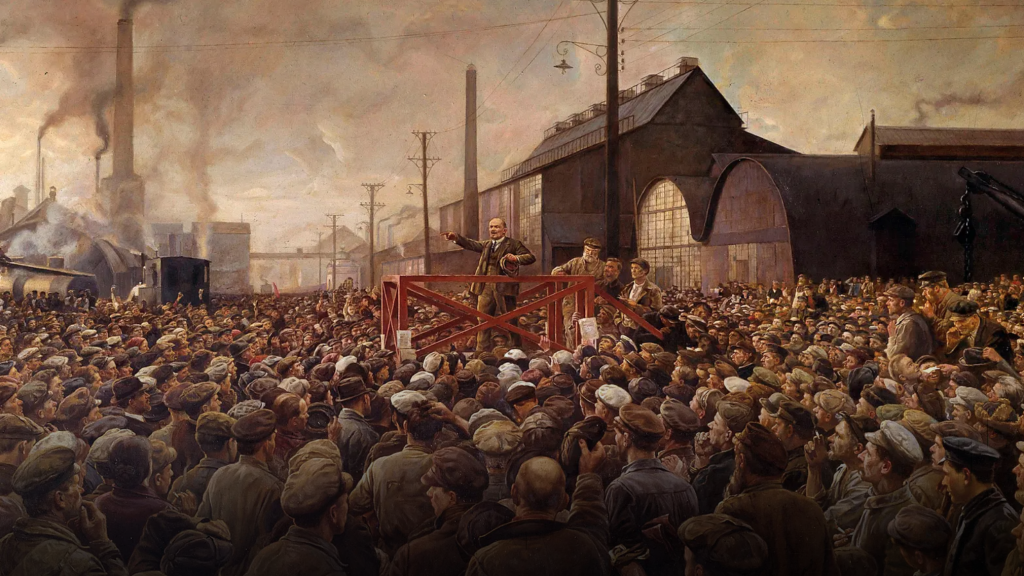The spectre of revolution: The 1917 Russian revolution failed, but its influence remains strong even now

[Editor’s note: On the occasion of the anniversary of 1917 Russian revolution, jailed Russian Marxist Boris Yulievich Kagarlitsky sent the following text addressing fundamental questions of revolutionary development. Kagarlitsky is currently in a Russian penal colony serving a five-year sentence for speaking out against the full-scale invasion of Ukraine. To support the campaign for his release visit freeboris.info.]
First published in Russian at Rabkor’s Telegram channel. Translation and footnotes by Dmitry Pozhidaev for LINKS International Journal of Socialist Renewal.
This year, on November 7, public interest, regardless of political views, is not focused on the anniversary of the revolution but on the results of the elections in the United States. This is, in essence, correct. No matter how much we respect history, we must live in our time with its problems, passions and contradictions. However, if we are to speak about the 1917 Russian revolution, does it belong exclusively to history? The fact that even today people argue, debate, and even quarrel over assessments of those events proves that the topic has not lost its relevance.
I have said it many times before and will now repeat my thesis that the process initiated on November 7, 1917, is far from complete. The revolution failed, but its spectre still wanders — primarily in Russia.
In using the word “failure”, I risk provoking a wave of indignant comments pointing to the victory of the Reds in the Civil War, the successes of the first Five-Year Plans, and so on. Therefore, it is necessary to clarify. If the historical mission of October 1917 was to launch a process of socialist transformations in Russia and the world, we must unfortunately acknowledge that even where the political victory of the Bolsheviks and their followers seemed indisputable for a long time, capitalism now prevails. This applies to China as much as it does to the states that emerged from the former USSR.
The success of the Russian Revolution and other early socialist revolutions, including the Chinese, Vietnamese and Cuban, lies in the radical modernisation of various aspects of life in the societies that experienced them. Moreover, modernisation occurred everywhere at a rapid pace and on a scale that is virtually unattainable for countries that avoided revolutionary upheavals.
Thus, the successes are indisputable. Just as indisputable (at this moment) is the defeat. The society formed as a result of these upheavals did not become the realisation of a socialist project, did not provide for democratic self-governance of the working people, and did not create a mechanism for systematically addressing the problems and tasks of development recognised by humanity. The restoration of capitalism (whether official, as in Russia, or bashfully disguised under red flags, as in China — complete or partial) became nothing more than a consequence of this failure.
However, revolution is not merely the seizure of power by the left, the proclamation of slogans, or the re-labelling of ideologies. It is a substantive, albeit painful, resolution of capitalism’s accumulated contradictions, a transition to a new phase of development. The practice of contemporary capitalism shows that revolutionary tasks are still on the agenda.
I risk repeating myself (for I have spoken and written about this many times), but the revolutionary process, as we see from past experience, goes through several stages. From democratic popular mobilisation led by moderate reformers, through to the dictatorship of the revolutionary party (the Jacobins and the Bolsheviks), and then Thermidorian-Bonapartist regimes, to restoration. In fact, we are now in a phase of restoration, which has certainly stretched out but is inexorably approaching its end.
The content of the future era will be what is referred to in English history as the Glorious Revolution, when society again returns to the path of development marked by the original revolutionary upheavals, but without the excesses and extremes that characterised them previously.
A new era of reforms and revolutions is inevitably approaching. The only question is whether we can rise to the challenges posed by history.
Otto Rühle
From the Bourgeois to the Proletarian Revolution
1924
Table of Contents:From the Bourgeois to the Proletarian RevolutionForeword
1. The Bourgeois Revolutions
2. The Russian Problem
3. The Bourgeois-Capitalist State
4. Parliament and Parties
5. The Trade Unions
6. The Last Phase Of European Capitalism
7. Factory Organisation And Workers' Union (1)
7. Factory Organisation And Workers' Union (2)1. The Origins of the Unionist (Arbeiterunion) Movement
2. Nature and Goal of the AAUD-E
3. Structure of the Betriebsorganisation (Factory Organisation)
4. Structure of the Union (Councils' Organisation)
5. Tactics
6. Nature of Administration
7. Membership
8. The Councils' System
9. The Proletarian Revolution
Footnotes
No comments:
Post a Comment